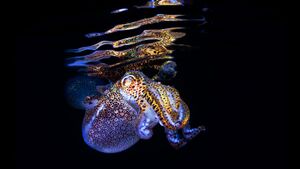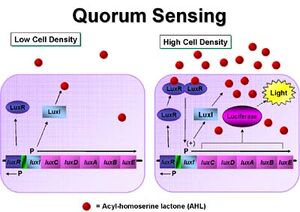Role of the Lux Operon in Bioluminescence: Difference between revisions
No edit summary |
No edit summary |
||
| Line 24: | Line 24: | ||
==Section 1 Microbiome== | ==Section 1 Microbiome== | ||
[[Image:QSluxOp.jpg|thumb|300px|right|Visual representation of the quorum sensing in areas of high vs low cell density. Source: Quorum Sensing and Genetic Circuit Design[http://www.cheme.caltech.edu/groups/fha/old_website_2010.6.25/quorum.html].]] | |||
Include some current research, with at least one image.<br><br> | Include some current research, with at least one image.<br><br> | ||
==Section 2 Genetics== | ==Section 2 Genetics== | ||
The mechanism that allows the Hawaiian Bobtail Squid to glow at night but not during the day is actually a result of gene expression in the bacteria, more specifically expression of the lux operon. | The mechanism that allows the Hawaiian Bobtail Squid to glow at night but not during the day is actually a result of gene expression in the bacteria, more specifically expression of the lux operon. | ||
Revision as of 13:38, 8 December 2021
Introduction

The lux operon has long been studied for its unique gene product: bioluminescence. Found in the bacterium Vibrio fischeri, the lux operon is an essential part of the bacterium's genetic code. In fact, the bacterial bioluminescence produced by the Vibrio fischeri bacteria plays an essential role in many mutualistic relationships with other organisms. One such organism is the Hawaiian Bobtail Squid (Euprymna scolopes).
The mutualistic relationship that exists between the Hawaiian Bobtail Squid and its bacterial partner Vibrio fischeri
At right is a sample image insertion. It works for any image uploaded anywhere to MicrobeWiki. The insertion code consists of:
Double brackets: [[
Filename: PHIL_1181_lores.jpg
Thumbnail status: |thumb|
Pixel size: |300px|
Placement on page: |right|
Legend/credit: Electron micrograph of the Ebola Zaire virus. This was the first photo ever taken of the virus, on 10/13/1976. By Dr. F.A. Murphy, now at U.C. Davis, then at the CDC.
Closed double brackets: ]]
Other examples:
Bold
Italic
Subscript: H2O
Superscript: Fe3+
I don't know
Section 1 Microbiome

Include some current research, with at least one image.
Section 2 Genetics
The mechanism that allows the Hawaiian Bobtail Squid to glow at night but not during the day is actually a result of gene expression in the bacteria, more specifically expression of the lux operon.
At night, abundant AHL molecules bind to the transcription factor luxR, which regulates gene expression of the operon. The newly bound complex moves and binds to the lux box, changing the secondary structure of the complex. This change allows the RNA polymerase to stay on the gene and transcribe all of the genes contained in the operon. The genes luxA and luxB produce the alpha and beta subunits of the luciferase enzyme, respectively. Luciferase is the enzyme responsible for bioluminescence in the bacteria Vibrio fischeri, as well as in many other bioluminescent organisms.
Conversely, during the day the squid limits light production by the bacteria. Low levels of AHL within the squid’s light organ cause RNA polymerase to bind to the promoter, transcribing luxR. Then, RNA polymerase binds to the other promoter and transcribes the luxI gene, producing LuxI as a result. LuxI binds to the substrate to catalyze the production of AHL, then RNA polymerase falls off of the strand. This means that AHL is constantly produced, allowing the levels of AHL to increase until the bioluminescent properties of the bacteria become useful to the squid after dark, and the squid begins to glow again.
Conclusion
Overall text length (all text sections) should be at least 1,000 words (before counting references), with at least 2 images.
Include at least 5 references under References section.
References
Citations: [1]
[2]
A citation code consists of a hyperlinked reference within "ref" begin and end codes.
Edited by Lauren Lehr, student of Joan Slonczewski for BIOL 116 Information in Living Systems, 2021, Kenyon College./
- ↑ Swartzman, A., Shalini Kapoor, A. F. Graham, and EDWARD A. Meighen. "A new Vibrio fischeri lux gene precedes a bidirectional termination site for the lux operon." Journal of bacteriology 172, no. 12 (1990): 6797-6802.
- ↑ Lyell, Noreen L., Anne K. Dunn, Jeffrey L. Bose, and Eric V. Stabb. "Bright mutants of Vibrio fischeri ES114 reveal conditions and regulators that control bioluminescence and expression of the lux operon." Journal of bacteriology 192, no. 19 (2010): 5103-5114.
